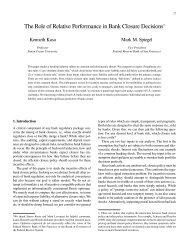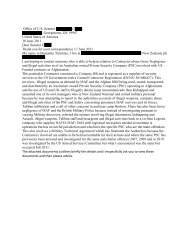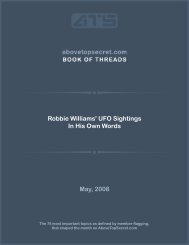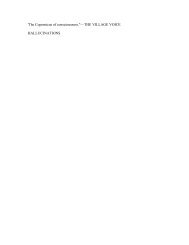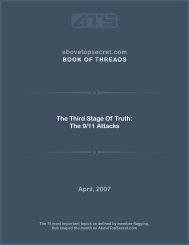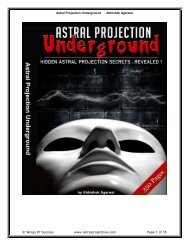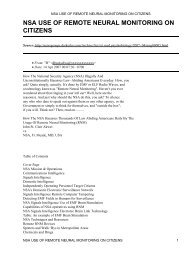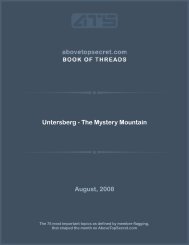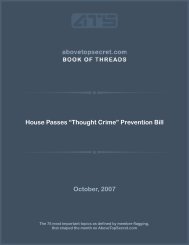them. These apparitions are scarce, to tell the truth. But why should it be otherwise? Is it notenough for one <strong>of</strong> us to see an Angel, in order for all <strong>of</strong> us to believe in the other Angels?Paracelsus was probably born in 1493, and only two years earlier Facius Cardan had recorded hisobservation <strong>of</strong> seven strange visitors directly related to the creatures <strong>of</strong> the elements who would beso puzzling to the great philosopher. The incident is preserved in the writings <strong>of</strong> his son, JeromeCardan (1501-1576), who is well known to us today as a mathematician.Jerome Cardan lived in Milan and was not only a methematician but also an occultist and aphysician. In his book De Subtilitate, Cardan explains that he had <strong>of</strong>ten heard his father tell theparticular story and finally searched for his record <strong>of</strong> the event, which read as follows:August 13, 1491. When I had completed the customary rites, at about the twentieth hour <strong>of</strong>the day, seven men duly appeared to me clothed in silken garments, resembling Greek togas,and wearing, as it were, shining shoes. The undergarments beneath their glistening andruddy breastplates seemed to be wrought <strong>of</strong> crimson and were <strong>of</strong> extraordinary glory andbeauty.Nevertheless all were not dressed in this fashion, but only two who seemed to be <strong>of</strong> noblerrank than the others. The taller <strong>of</strong> them who was <strong>of</strong> ruddy complexion was attended by twocompanions, and the second, who was fairer and <strong>of</strong> shorter stature, by three. Thus in all therewere seven. He left no record as to whether their heads were covered. They were about fortyyears <strong>of</strong> age, but they did not appear to be above thirty. When asked who they were, theysaid that they were men composed, as it were, <strong>of</strong> air, and subject to birth and death. It wastrue that their lives were much longer than ours, and might even reach to three hundredyears' duration. Questioned on the immortality <strong>of</strong> our soul, they affirmed that nothingsurvives which is peculiar to the individual... When my father asked them why they did notreveal treasures to men if they knew where they were, they answered that it was forbiddenby a peculiar law under the heaviest penalties for anyone to communicate this knowledge tomen. They remained with my father for over three hours. But when he questioned them as tothe cause <strong>of</strong> the universe they were not agreed. The tallest <strong>of</strong> them denied that God hadmade the world from eternity. On the contrary, the other added that God created it frommoment to moment, so that should He desist for an instant the world would perish.... Be thisfact or fable, so it stands.Nearly three centuries later, in September 1768, a young man <strong>of</strong> sixteen was traveling to theUniversity <strong>of</strong> Leipzig with two passengers from Frankfurt. It rained most <strong>of</strong> the journey, and thecoach sometimes had trouble moving uphill. On one occasion when the passengers had left theirseats to walk behind the horses, the young man noticed a strange luminous object at ground level:All at once, in a ravine on the right-hand side <strong>of</strong> the way, I saw a sort <strong>of</strong> amphitheatre,wonderfully illuminated. In a funnel-shaped space there were innumerable little lightsgleaming, ranged step-fashion over one another; and they shone so brilliantly that the eyewas dazzled. But what still more confused the sight was that they did not keep still, butjumped about here and there, as well downwards from above as vice versa, and in everydirection. The greater <strong>of</strong> them, however, remained stationary, and beamed on. It was onlywith the greatest reluctance that I suffered myself to be called away from the spectacle,which I could have wished to examine more closely.... Now whether this was apandemonium <strong>of</strong> will-o'-the-wisps, or a company <strong>of</strong> luminous creatures I will not decide.The young man in question was Goethe. You will find this sighting in the sixth book <strong>of</strong> hisautobiography, according to movie director and occult scholar Kenneth Anger, to whom I amindebted for this very interesting discovery. Would the German poet and scientist have had occasionto learn more about the "luminous creatures" had he lived in the twentieth century? If Paracelsus
came back, would he find new material for his theories on the nature <strong>of</strong> the strange and fugitiveraces <strong>of</strong> beings from the sky? We can safely assume that their attention would be immediatelyattracted to the modern files <strong>of</strong> UFO landings and abduction reports.Return <strong>of</strong> the HumanoidsOne night in January 1958, a woman whose name I am not authorized to publish was driving alongthe New York State Thruway, in the vicinity <strong>of</strong> Niagara Falls, in the midst <strong>of</strong> a violent snowstorm.The exact time was 1:30 A.M. She was going to visit her son, then in the army, and she was drivingvery carefully, trying to find an exit, for she believed the Thruway was closed ahead <strong>of</strong> her.Visibility was extremely bad. Hence she had no chance to think when she suddenly saw whatseemed to be an airplane wreck on the center parkway:A large shape was visible, and a slim rod at least fifty feet high was illuminated and gettingshorter as though it were sinking into the ground. My motor slowed down and as I camecloser my car stopped completely. I became panicky and tried desperately to start it as I hadno lights.My first thought was to get out and see what was happening but I suddenly saw two shapesrising around that slim pole which was still growing shorter. They were suspended butmoving about it. They seemed to be like animals with four legs and a tail but two frontfeelers under the head, like arms. Then, before I could even gasp the things disappeared andthe shape rose and I then realized it was a saucer, it spun and zoomed about ten feet <strong>of</strong>f theground and up into the air and I could net even see where it went.My lights suddenly came on. I started the car and it was all right. I pulled up to that place,got out with a flashlight and walked over to where it had been sitting. A large hole wasmelted in the snow about a foot across and grass was showing on it. The grass was warm,but nothing was dug up around there.The woman, who met only with disbelief when she told her story to her family, reported the case ina letter to my correspondent Otto Binder when his syndicated series "Our Space Age" began toappear in a number <strong>of</strong> newspapers.The most puzzling element in this account is not so much what is described but the fact that suchstories have become, since 1946, rather common in all parts <strong>of</strong> the world. To a physicist, <strong>of</strong> course,they appear unbelievable, just as the strange manikin met by St. Anthony would appearunbelievable to a biologist. And yet there are several cases on record in which similar accounts areassociated with traces that can hardly be questioned.In the celebrated incident at Socorro, New Mexico, it was a policeman, Lonnie Zamora, whoreported seeing two small beings, dressed in white, close to a shiny egg-shaped object, which restedon four pads before it took <strong>of</strong>f with a thunderous noise, only to become perfectly silent as it flewaway. The incident took place on April 24, 1964, and was the occasion for some interestingmeasurements (by local police <strong>of</strong>ficials and a Federal Bureau <strong>of</strong> Investigation man) <strong>of</strong> the traces leftby the object. Here again we observe an emotional pattern strangely reminiscent <strong>of</strong> the medievalscene just surveyed: the witness in the Socorro case, when he was about to be interviewed by AirForce investigators, was so little convinced that he had observed a device <strong>of</strong> human constructionthat he asked to see a priest before releasing his report to the authorities.Another case hard to discount is the report <strong>of</strong> the Kentucky family who claimed to have beenbesieged by several "little men," whose appearance was completely fantastic. The incident occurredon the night <strong>of</strong> April 21, 1955, and was the occasion <strong>of</strong> many strange observations <strong>of</strong> the behavior<strong>of</strong> the "visitors." One <strong>of</strong> the creatures was seen approaching the farmhouse with both hands raised.When it was about twenty feet away, two <strong>of</strong> the witnesses shot at the intruder. It "did a flip" and waslost in the darkness. Then it appeared at the window when the man came back inside the house and
- Page 3 and 4: Foreword by Whitley StrieberThere a
- Page 5 and 6: It is sad that, as the twentieth ce
- Page 7 and 8: PART ONE: THE ALIEN CHRONICLESIn th
- Page 9 and 10: lot about it, but nobody said 'Let'
- Page 11 and 12: The resemblance of the Dogu statues
- Page 13: various forms of error worship unde
- Page 18 and 19: was again shot at. Another creature
- Page 20 and 21: The story is fantastic. Yet it remi
- Page 22 and 23: their virginity in the sanctuaries
- Page 24 and 25: A letter from a British woman begin
- Page 26 and 27: The recollections of the legionnair
- Page 28 and 29: lades. In less time than it takes t
- Page 30 and 31: e called Smith said: "No, we cannot
- Page 32 and 33: Celtic legends, along with the docu
- Page 34 and 35: probably took place in the second p
- Page 36 and 37: Australian Air Force Intelligence p
- Page 38 and 39: ings in the fields and prairies?One
- Page 40 and 41: From behind the object, two beings
- Page 42 and 43: "in smooth English." They did not s
- Page 44 and 45: to four feet tall, dressed in white
- Page 46 and 47: expectations as if they were mere t
- Page 48 and 49: came out of it, but this person was
- Page 50 and 51: 6. When men did not inhabit most of
- Page 52 and 53: the negative reactions of scientist
- Page 54 and 55: other in appearance, dress, mode of
- Page 56 and 57: saw that they had made a grin, he h
- Page 58 and 59: and rode out after dark in search o
- Page 60 and 61: sighting, and the Sonny Desvergers
- Page 62 and 63: PART TWO: ANOTHER REALITYDuring the
- Page 64 and 65: pencil in a buttonhole with a piece
- Page 66 and 67:
short perpendicular line on each en
- Page 68 and 69:
sudden displacement of warm air or
- Page 70 and 71:
popular today. But a second - and e
- Page 72 and 73:
ecorded about 1825 in the Vale of N
- Page 74 and 75:
The ikal of the Tzotzils flies thro
- Page 76 and 77:
the door, he turned and recieved a
- Page 78 and 79:
If Stewart came back today, he woul
- Page 80 and 81:
The devil does not have a body. The
- Page 82 and 83:
interested in the social implicatio
- Page 84 and 85:
Very well, little son. Come back to
- Page 86 and 87:
measure. But the phenomenon does ap
- Page 88 and 89:
and physical, to determine whether
- Page 90 and 91:
previous year. But the fact remains
- Page 92 and 93:
Do Not Report This!Accounts such as
- Page 94 and 95:
least one occasion, experienced lev
- Page 96 and 97:
deep unconscious level of the symbo
- Page 98 and 99:
much as twenty hours a day, and in
- Page 100 and 101:
against me as I stood bracing mysel
- Page 102 and 103:
another one, but this was very defi
- Page 104 and 105:
not natural, was witnessed by perso
- Page 106 and 107:
The predicted miracle took place as
- Page 108 and 109:
The phenomenon, it seems, could not
- Page 110 and 111:
in the final analysis.Many of us wi
- Page 112 and 113:
already surrounded....I was told wh
- Page 114 and 115:
Since the publication of my earlier
- Page 116 and 117:
”A bright flash”Fatima, May 13,
- Page 118 and 119:
The Invisible CollegeAfter some thi
- Page 120 and 121:
the Air Force met in Dallas and dis
- Page 122 and 123:
panel of scientists could rapidly b
- Page 124 and 125:
it had been hovering there was now
- Page 126 and 127:
like piezo-electricity, or static e
- Page 128 and 129:
the group teachings and advice. The
- Page 130 and 131:
This is a frightening view, one tha
- Page 132 and 133:
John McCoy, who coauthored with Wil
- Page 134 and 135:
of reports about "the robots" and "
- Page 136 and 137:
eathe our air. They walked normally
- Page 138 and 139:
the designation Wolf 424.The myster
- Page 140 and 141:
a scar or a mark. The authorities w
- Page 142 and 143:
esearches might have a bearing on a
- Page 144 and 145:
me undeniable) and as psychic devic
- Page 146 and 147:
extraterrestrial theory is not stra
- Page 148 and 149:
the universe summarizes the problem
- Page 150 and 151:
About the AuthorAn astrophysicist b



